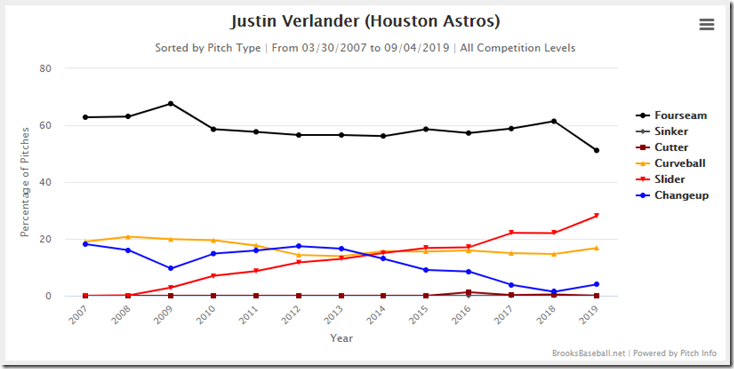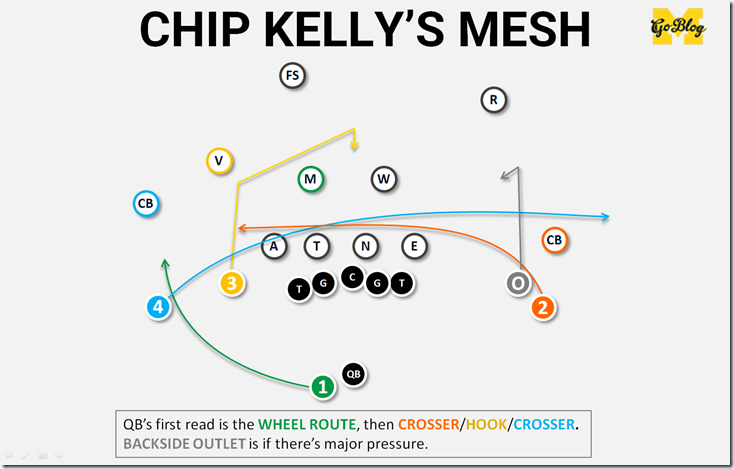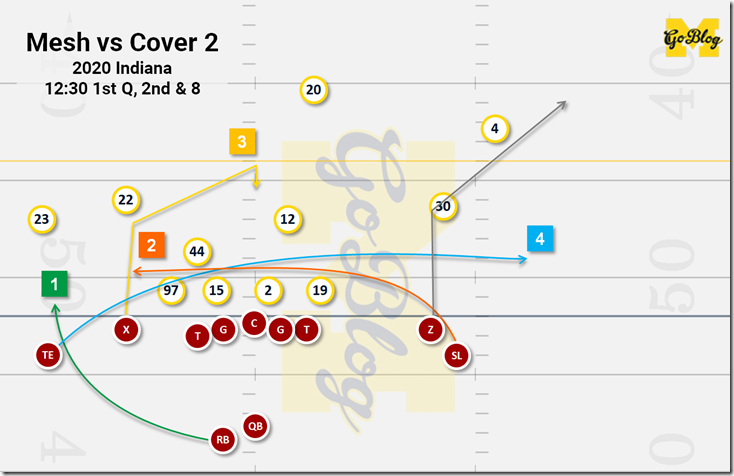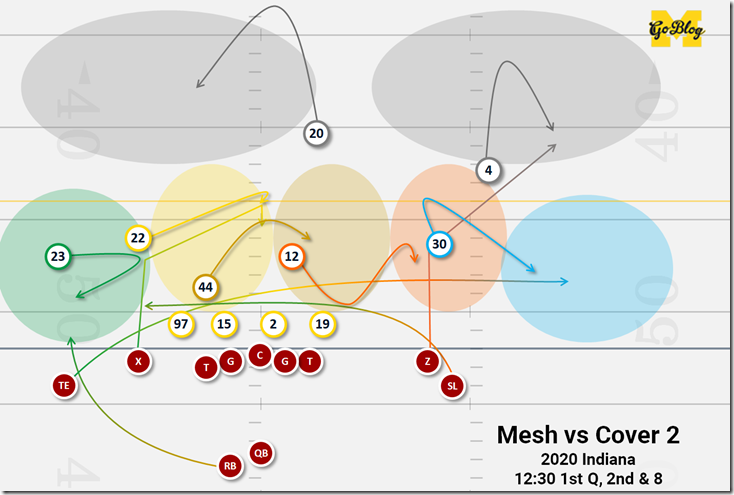
Neck Sharpies: Four Pitches for Mesh

If you follow enough baseball you're familiar with the concept of a pitcher's second career. The story's always more complex but in broad strokes the kid who comes out dominating with a 101-mph fastball, and the things having a nuclear fastball lets you get away with, slowly builds up his repertoire as the heat begins to dissipate.
This doesn't even show it but Verlander's fastball rate dropped under 50% in 2020
Michigan's defense under Don Brown used to be that dominant fastball-changeup kid. As offenses adapted he was working in more offspeed stuff that play off the fastball, but didn't change the overall approach. That's not insane. If you're going to use your changeup as your primary pitch, you'd better be Luis Castillo. Or Iowa.
This year however they reached that inflection point. It's a dramatic one not only because Lavert Hill was replaced by a downgrade in Gemon Green, but their blazing heater Ambry Thomas opted out and the rest of the depth chart is so weak a shitty MSU rookie can knock them all over the yard. It looks so disorganized because everyone else is trying to make up for it. The DL is jumping the snap to add pressure. They're running more 3-3-5 and stunts for the same reason.
They're doubly unfortunate because downfield chucks are an underused play in the Big Ten. They're relatively low-risk, the ball gets out too quickly for your pass protection to matter, receivers have more game practice on them because they all caught a lot of fades in high school, and cornerbacks are disadvantaged even when they win the route because OPI is rarely called, and if they get run over by the receiver it's usually a flag. However lizard-brained coaches often think in terms of binary success rates, and eschew "low-percentage" plays with high upside. How many times have you heard a coach essentially apologizing for throwing downfield "just to keep them honest"? Show most coaches, especially underdogs, a flashing "Throw at Me!" sign, however, and they'll start doing the thing they should have been doing more of all along. We're making them more efficient than they want to be!
Mesh
When talking in overall defensive structure there's too much to discuss, so let's pare it down to one play that's in almost every offense, and was a big part of Indiana's gameplan: MESH.
This is the Air Raid's base play. A lot of teams that run it, including Indiana and Ohio State, teach their crossers to high-five as they go by in order to get the right amount of spacing for the pick.
MESH is so loved because it's a play with a high upside and a high floor that isn't hard to teach and works against all defenses. It's been especially popular in the last decade as refs at all levels stopped calling the pick part offensive pass interference as long as the pick man tries to go on with his route. Also because teams have gotten used to running it with a leaky running back like above, which overloads defenses' ability to cover it.
If you catch man-to-man, the crossers create a natural pick route for one another, and give your crossers the leverage to take advantage of any speed differential between themselves and whoever's covering them. For this reason teams run MESH often against man defenses where they have a matchup disparity (e.g. Michigan used to match Zach Gentry against linebackers).
MESH also works against zone, because the crossers will be touring all of the linebacker zones, and can sit down in empty space between them. If you catch a blitz, you have two short reads to get the ball out in spaces that the blitz left open. If defenses start activating safeties against underneath routes you've primed them to get torched by deep ones.
It's also easy to teach your quarterback. You start by reading the MIKE (the playside ILB) to see if he's bailing for the RB. MIKE running outside means you probably have man-to-man, and one of the defenders potentially in between the crossing routes is no longer there. MIKE staying inside means the edge of the defense hasn't compensated for the extra player you sent there…yet. After this sweep from the middle to the edge, the QB knows all he needs to make his reads. If the mesh cleared out underneath, throw it to the RB. If it didn't, check the crosser emerging toward that edge. If that guy's covered, flick your eyes above him to see if the middle of the field was abandoned. And if the defense did shift everybody, you've got one-on-one coverage across all that traffic to the guy coming out the backside.
[After THE JUMP: Three ways to defend it]
Cover 1
The simplest way to cover Mesh would be to stay in man coverage and keep up. Call it the fastball. If your cornerbacks can make up ground on receivers as they cross they should be in position to tackle on the catch, which makes this a two- or three-yard completion. Part of doing that is to keep your defenders clear, with what Charles Woodson calls a "Lock & Levels" alignment. That means your defenders over a bunch formation all get their own vertical lanes. Notice how the horizontal plane for each of these defenders is clear.
Of course somebody then has to be the deepest level, and Mesh teams will look to make that guy the one going across, the formation, making every yard between him and the line of scrimmage a yard he has to make up.
#4 at the top of the screen.
Michigan's problem with defending this in man is they don't have the cornerbacks to keep up with Ohio State's five-stars replacement-level Big Ten starters, let alone make up ground on them. Michigan doesn't have a fastball.
Doubles Coverage
But they do have a changeup. If you recall last year Michigan had a "Doubles" coverage, where they pick two receivers to double-team and leave everyone else in man. This let them give Vincent Gray safety help.
This one gave up the first down because the tight end tripped and turned that into an accidental cut block on Daxton Hill. Dax still got around it and had a tackle attempt after a three-yard gain but missed his tackle. The WR on the bottom ran his #3 route directly into Hawkins so Vincent Gray was freed up to make a play on this, but that's a vamp. Gray's job is to bracket WR #3 so Gray is there if there's a scramble and #3 cuts to the sideline. He's not yet comfortable enough running this to go off-script to make a play.
It's still man to man but you're using your safeties to cover weaknesses, allowing your better man to man defenders to ply their trade. It's a good passing down defense, but you can't stay in this all day because everybody in man defense isn't defending the run.
Cut Calls
Michigan does have a cutter. Watch McGrone casually step in the middle of this and knock the tight end off his route.
This is a "Cut" call. If you're playing against Mesh a lot this is an extra. However you'll note McGrone has no running back on that side. The backside is actually the WR at the bottom, who's all alone with Vincent Gray. This is why Mesh usually has that swing out of the backfield, otherwise the defender is right where you don't want him.
The downside is you need that LB available, not blitzing. Indiana was hoping Michigan was bringing McGrone on a five-man pressure, as they do often.
True Zone Defense
Here's the first of IU's many mesh plays from Saturday, versus a Cover 2 zone by Michigan.
It's actually well-defended. IU has been practicing for Michigan's man to man defense, which would expect #23 Michael Barrett at the bottom to travel with the tight end he's matched against. Penix read the MIKE, #44 Cam McGrone, who would be the guy taking a running back out of the backfield in a man-to-man case. McGrone is dropping into a zone though. Zone means there should be room on the backside, and sure enough the VIPER #23 Michael Barrett has moved inside the 50 marker.
But Barrett's eyes are on the quarterback. He carried the TE for a few steps to make sure a quick slant is contested, but he springs back to the flat. We're watching just Barrett here:
Streeeeeeeeeeetch….SPRONG!
Hide the Zones
The trick to developing a different pitch is can it do things that make it harder to hit it, and can you locate it. It's the same thing with a secondary defensive philosophy. You should have some unique talents on the field to exploit by giving them harder jobs they can execute regularly. But you can't run it at all if you can't be in the right spot.
I think we misinterpret zone defense for people by constantly showing just circles on a map. If you try standing in one spot in NCAA 2014 you'll get a lot of passes in your face. Zone defense is a lot more about paths, and coverage responsibilities often include guys not in your zone.
This leads us to our first law of zone: CARRY TO LEVERAGE THEN SPRING BACK.
Zone coverage is a leverage game: you cover the guy you have the best leverage to cover, and when that's not you anymore you're supposed to hand him off to the next zone and snap to the next guy entering yours. Note that the edges of the field are leverage.
What you saw from Barrett in the above instance was a good example of zone technique. He carried that tight end at the start, but with his eyes on the quarterback and ready/in position to spring back if the ball went outside. Coaches who teach this often use "Banjo" or "Rubber Band" or a similar metaphor to describe this style of stretching and springing.
This, as you might imagine, takes a LOT of practice. Even a bad man-to-man defender should usually be in the general area and able to contest bad throws. A zone defender who loses track of where he's supposed to be is how you get pictures of dudes so wide open nobody else is in the shot.
Using motion and a flexed tight end, IU tested Barrett's ability to play the Cover 2 zone that's usually reserved for cornerbacks, and giving him obstacles. It was a good thought, but Barrett rubber banded well.
But it wasn't that natural for everybody. I'll let you try to guess the guy who's supposed be cutting this crosser off.
No, not Gray. It was McGrone, who was supposed to bluff his blitz to get Dax in free. However Michigan screwed up the timing, the RT was alerted to Dax, and then McGrone got stuck for an extra beat behind him. Gray did get a little lazy with tracking the TE, making the crossing route to #3 Whop Philyor (his second read) a bit easier.
That leads us to our second beyond-the-basics rule of good zone defense: MAKE READS DIFFICULT. If we're going with the baseball analogy, it's not how much your slider moves but where it moves. You're not a robot out there. A good zone defense is hard to play against because zone defenders will bait you into bad reads. A fake blitz with McGrone only for him to drop into the #2 read is one example.
Bring Pressure
The last way Michigan defended Mesh was the way Don Brown says he wants to solve his problems: with aggression. It helps if you're backed up to the goal line, since there's no need for a safety. This is a Cover Zero six-man pressure.
And it was actually open, as Hawkins wandered off toward the first read. Of course Penix can't get to his third read because the pressure outmanned his blocking and he has however long it takes Dax Hill to cover that much ground before the ball has to be out. Vincent Gray also knows Penix won't get to the backside read, and has set up to help with the quick outlets.
So what's Michigan's deal? They've got a lot to clean up if they're going to be a base zone team. They can run the base thing but they're either too timid to vamp (see Gray above) or don't have the timing down (see the McGrone fake blitz) or too aggressive because they think a vertical release outside means the ball's going at Gray again (see blood):
Or because they think it isn't? (if you put this on Ross)
But they have enough other pitches that, if there isn't another cornerback they can unearth mid-season, I think it's the right way to go. They're going to get knocked around the park, but improving their zone has upside that their fastball apparently does not.
November 10th, 2020 at 4:49 PM ^
Well done!
November 10th, 2020 at 5:00 PM ^
Great analysis as usual, Seth. Here’s to mastering some new pitches.
November 10th, 2020 at 5:10 PM ^
We absolutely have the personnel to make this a base play. Jackson, Sainristil, Wilson, Henning, Bell, and even Evans, Corum, and Charbonnet are perfect for this. Add in CJ and you have a great hitch threat.
Why do we seem to believe that offense should be hard? Sometimes I feel like we are the Redcoats fighting the Native Americans in Last of the Mohicans. Organized, honorable, and incredibly stupid.
November 10th, 2020 at 5:31 PM ^
Big Ten Defenses- Sing It "No matter where you go I will find you.."
November 10th, 2020 at 5:59 PM ^
Did we read the same post? I agree Michigan has personal to continue running mesh, but this post was about the defensive response to other teams running mesh
November 11th, 2020 at 12:23 PM ^
Agree. Note further that just because Michigan has struggled to cover mesh in the time since Don Brown arrived (and maybe before) doesn't mean that other teams struggle to defend it as much as Michigan does.
November 10th, 2020 at 5:43 PM ^
Nice write-up. I love the practice of walling off the mesh with LBs. Sorry to keep ragging on the kid, but I think Gray is just not starter material. He seems slow to react and his movements are not quick twitch. He’s slow in man and just doesn’t have the bend in his legs to read and react in zone. I’m just not seeing what the coaches are seeing.
November 10th, 2020 at 7:26 PM ^
Just how much worse the other CBs behind him if they can't beat him out for PT. We already saw it with Perry who didn't fare well two weeks ago.
November 10th, 2020 at 6:45 PM ^
In the NFL you can’t make contact more than 5 yards downfield, but that isn’t the college rule. That being the case, I don’t get why you don’t have the ILBs just crush any crossers?
November 11th, 2020 at 12:25 PM ^
That is what McGrone did in one of the examples above. That being said, defensive holding is still a thing, so you can't be too aggressive with the crushing.
November 10th, 2020 at 6:50 PM ^
The last way Michigan defended Mesh was the way Don Brown says he wants to solve his problems: with aggression.
Can someone help me out here. Why do we need to bring extra men to generate a pass rush? Paye is supposed to be a first round projection, which for what's it's worth I have argued is not an explosive pass rusher, but rather a solid effort guy who's a good run defender, but I digress. Hutch is a high level recruit who is 6'6" and seems to use his hands well. Hinton is a 5-star and he's not a freshman any longer. and is 300-plus pounds And whomever is at the other DT, whether it be Jeter (4-star) or Kemp (4-star), you'd think they'd be above average. So, why can't a senior DE first round projection, a 5-star sophomore DT, a 4-star DT, and a high 4-star 6'6" DE generate a quality pass rush on their own? One of a few things is a reality. One, Paye & Hutch are not great pass rushers and/or two, Hinton, Jeter, & Kemp are way overrated as recruits or underdeveloped by the coaches. The only other thing to consider is Kemp is playing out of position and his size and skill set doesn't translate to any position in P5 football. I find this incredibly frustrating. This is supposed to be on the best d-line units in the conference and they are shit. This is just another failure of our coaching staff. Either they didn't develop these guys or they didn't ID recruits very well. From what I can tell some dude from Germany who just picked up football several years ago is our best DT which is sad.
November 10th, 2020 at 6:53 PM ^
Mesh is a pretty fast play. A top notch pass rusher can be doubled or chipped and that's all she wrote. Paye did get pressure on a few of these. Watch the Cut play.
November 11th, 2020 at 7:05 AM ^
I was watching the game on DVR. I didn't do it the entire game, but after getting frustrated I started pausing the game a few seconds after the snap for both teams. The vast majority of the time Penix had a nice clean pocket to scan the field from and had time to look at multiple WRs. Our d-line was not beating their guys off the snap very often. When UM had the ball the same was not true for Milton as often.
I've always though that both Hutch & Paye were merely OK pass rushers and better run defenders and we all know Kemp's issues. My biggest surprise is I'm not seeing any year two improvements for Hinton, or at least not enough to generate much of a pass rush. Shouldn't a 5-star in year two be doing more? I was waiting for some Malik McDowell sophomore year production and he's simply not that.
Sadly, the few guys I saw flashing in the backfield most often were Newburg & Welschoff late.
November 10th, 2020 at 6:54 PM ^
Wasn’t BJM supposed to be a zone guy? Can he help stop the bleeding?
Looks like we could have used Shoop in a hands on role this year.
Also with no Hutchinson the 3-3-5 is dead right? Right?
November 10th, 2020 at 8:30 PM ^
I mean, it seemed pretty dead before he got hurt. If Seth wants to do it, it'd be interesting to see one of these where he tries to determine what the idea behind that 3-man front - what they were hoping to accomplish with it, and why it didn't work.
November 11th, 2020 at 6:28 AM ^
I don't think he's diagrammed it, but he's mentioned the problems with Michigan's 3-3-5 on numerous podcasts now. Basically, you gain a 4th DL by blitzing someone. It allows you to play a bunch of games that way. Problem is, kind of like zone here, it takes a lot of practice and if it's not your base you probably won't run it well (guys not blitzing the right gap, etc.).
November 10th, 2020 at 7:03 PM ^
I asked this in a diary post and only got one response so I'll give it another shot here (copy and paste).
Great stuff man. I was wondering (and seth, brian, space coyote, etc can feel free to make recommendations) what is the best way(s) to learn the game on this level? I played in high school and retain a lot of that but it was very basic and i want to learn as much as i absolutely can and get as detailed as i can. I would love to have the ability to rewatch a game and do a film review (kind of like a ufr). I own quite a few books but have a hard time staying awake when im reading a lot of times. However if your recommendation includes certain books, feel free. Keep the content coming and thanks.
November 10th, 2020 at 7:29 PM ^
There are many websites/blogs that have really good articles on various offensive and defensive concepts and schemes. I’m not sure how reading on a computer and reading a book are different though. Bottom line, you have to read. Without the benefit of coaching the game at the high school varsity level or above, those are the best (only?) resources available. I have coached for almost 2 decades and I read constantly. Of course i watch an absurd amount of film too. We also have the benefit of setting up meetings with various college staffs if there is a particular scheme we want to learn, but non-coaches don’t have that option.
November 11th, 2020 at 6:16 PM ^
Thanks for the feedback. I'll be sure to check out some of those websites and blogs. I enjoy space coyotes breakdown sports. Its just figuring out where to begin thats a little tricky. Anyway, appreciate the content.
November 11th, 2020 at 12:25 AM ^
I started with Chris B. Brown's Smart Football. And watched A LOT of film. And watched coaches clinics on youtube. And more film. And a few more books. And then I started writing this in like 2013-2014 and because i was terrified of being exposed as a fraud I researched the hell out of everything I was writing and sought people who could review it, and ultimately that led to having a bunch of coaching types and other bloggers who write x's and o's whom I communicate with regularly, mostly on twitter dms.
November 11th, 2020 at 6:13 PM ^
Well i feel slightly better. I own two chris brown books. I know the feeling about being exposed. I practically bite my nails to the skin every time i comment about football on here. Thanks for the feedback, appreciate that and all the x and o's stuff all you guys post. Look forward to more.
November 10th, 2020 at 10:01 PM ^
Great writeup Seth....
I'm enough of not an idiot to say that Seth should be hired as a grad assistant, and teach this... because he sure as shit is eloquent and clear on it.
Isn't this the same play OSU used on Watson over and over ?
And why aren't we using this play often?
Seems to me that the DE should be trained to try to watch to keep eye on this mesh play and get hands up, because a tip could be deadly and a pick. Granted they don't have eyes on back of head maybe being extra aware and it can help thwarting it, instead of simply trying to get upfield as Brown's DL overly does.
November 10th, 2020 at 10:32 PM ^
I greatly appreciate Neck Sharpies. Thanks for teaching me more about schemes even though it hurts.
November 11th, 2020 at 1:10 PM ^
Quick question, on the fake McGrone blitz wouldn't that be BVS's responsibility according to Rule 1 about keeping leverage then stretch back? He kind of rode vertical with his guy a bit, then got behind. Shouldn'the have passed him back to a safety then gone back to the hook/curl zone? Or does leverage just apply laterally?
November 12th, 2020 at 9:12 PM ^
Or be prepared to win games 11 runs to 10 runs.





Comments